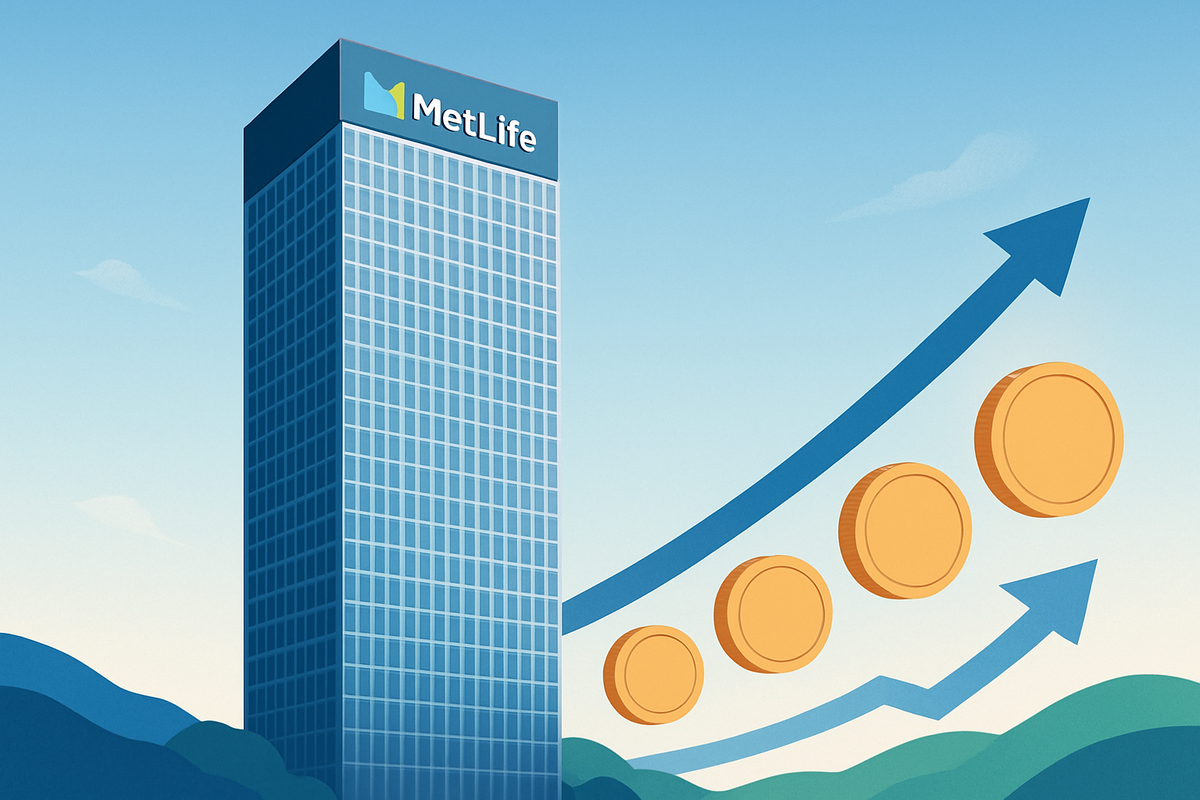
New York, NY – October 7, 2025 – MetLife, Inc. (NYSE: MET), one of the world's leading financial services companies, today announced a quarterly dividend of $0.5675 per share, maintaining its payout in line with previous distributions. This declaration underscores the insurer's consistent approach to returning value to shareholders and signals stability amidst evolving financial market conditions.
The steadfast dividend, payable on December 9, 2025, to shareholders of record as of November 4, 2025, translates to an attractive forward yield of approximately 2.74%. For income-focused investors, MetLife's predictable dividend policy offers a compelling proposition, reinforcing its position as a reliable component of a diversified portfolio. The announcement, made on the current date of October 7, 2025, sets the stage for eligible shareholders to receive their payout before the close of the year.
Detailed Coverage of MetLife's Dividend Declaration
MetLife's latest dividend declaration of $0.5675 per share for the upcoming quarter is a continuation of its well-established policy of consistent shareholder remuneration. This specific amount has been a recurring figure in recent quarters, reflecting a prudent financial strategy that balances capital allocation for growth and direct returns to investors. The announcement today, October 7, 2025, initiates a clear timeline for the dividend process. Shareholders who own MetLife (NYSE: MET) stock by the close of business on the record date of November 4, 2025, will be eligible to receive the dividend payment. The actual cash distribution will then occur on December 9, 2025.
This consistent payout is not an isolated event but rather a reflection of MetLife's broader financial health and its management's commitment to a predictable dividend strategy. Over the past several years, MetLife has demonstrated a strong track record of either maintaining or increasing its quarterly dividends, a characteristic highly valued by long-term and institutional investors. This stability is often interpreted by the market as a sign of robust earnings, efficient capital management, and confidence in future profitability, even as the insurance sector navigates macroeconomic shifts and regulatory landscapes.
Key stakeholders in this event include current MetLife shareholders, particularly those who rely on dividend income, as well as potential investors looking for stable, yield-generating assets. The announcement also provides a barometer for analysts assessing the company's financial discipline and its ability to generate free cash flow. While initial market reactions to a routine dividend declaration are typically subdued, the sustained payout contributes positively to investor sentiment, reinforcing trust in the company's financial stewardship.
Implications for Public Companies and Investors
MetLife's (NYSE: MET) decision to maintain its quarterly dividend at $0.5675 per share is largely positive for its existing shareholders, particularly those seeking stable income. For these investors, the consistent payout, coupled with a forward yield of 2.74%, provides a reliable stream of returns, making MetLife an attractive option in a potentially volatile market. This stability can also draw in new investors who prioritize dividend consistency and yield, indirectly boosting demand for MetLife's stock. Companies like MetLife, which demonstrate a commitment to shareholder returns, often enjoy a premium in valuation compared to peers with less predictable dividend policies.
Conversely, companies that operate in the same financial services and insurance sectors, such as Prudential Financial (NYSE: PRU), Aflac (NYSE: AFL), or The Travelers Companies (NYSE: TRV), might face increased scrutiny regarding their own dividend policies and yields. While MetLife's move doesn't directly impact their operations, it sets a benchmark for investor expectations within the industry. Companies unable to match or exceed such consistent dividend growth might find their stocks less appealing to income-focused investors. This dynamic fosters a competitive environment where financial strength and a clear capital return strategy become crucial differentiators.
From a broader market perspective, a strong, consistent dividend from a major player like MetLife can signal underlying health in the insurance sector. It suggests that despite economic uncertainties, large insurers are generating sufficient profits and possess adequate capital buffers to reward shareholders. This can bolster investor confidence in the broader financial services industry, potentially leading to increased investment flows into the sector as a whole. However, companies struggling with profitability or facing significant regulatory hurdles might find it challenging to maintain similar dividend levels, potentially leading to underperformance compared to their more robust counterparts.
Wider Significance and Industry Trends
MetLife's consistent dividend declaration is particularly significant within the broader context of the insurance industry, which is highly sensitive to interest rate fluctuations and economic cycles. In a potentially rising interest rate environment, insurers can benefit from higher investment income on their vast portfolios. However, they also face challenges related to investment volatility and the need to maintain strong solvency ratios. MetLife's ability to sustain its dividend payout signals its resilience and robust capital management strategies, suggesting it is well-positioned to navigate these dynamics. This stability serves as a positive indicator for the health of the life insurance and annuity sectors.
The event also highlights a broader industry trend among mature, well-capitalized financial institutions to prioritize consistent shareholder returns through dividends and share buybacks. This strategy aims to attract and retain long-term investors, providing a buffer against market downturns and signaling financial strength. Competitors and partners in the insurance ecosystem, including reinsurers and asset managers, closely observe such declarations. A strong dividend from a major insurer like MetLife can instill confidence throughout the value chain, indicating stable business conditions and reliable cash flows within the sector.
Regulatory bodies also pay close attention to the dividend policies of large insurers. Consistent and sustainable dividends typically reflect sound financial health and adequate capital reserves, which are key concerns for regulators focused on policyholder protection. Any significant changes or suspensions in dividend payments from a major insurer could trigger regulatory scrutiny, as it might signal underlying financial distress. Historically, during periods of economic uncertainty, companies that maintained their dividends were often seen as financially stronger and more trustworthy, providing a stark contrast to those forced to cut payouts.
The Road Ahead: What Comes Next for MetLife and the Market
Looking ahead, MetLife's (NYSE: MET) sustained dividend policy suggests a continued focus on balancing growth initiatives with direct shareholder returns. In the short term, the upcoming ex-dividend date (shortly after the November 4 record date) will likely see a minor adjustment in the stock price, a common market phenomenon. However, the consistent payout reinforces its appeal as a defensive stock, potentially attracting investors seeking stability during periods of market uncertainty. Long-term, MetLife is expected to continue optimizing its business segments, focusing on areas with strong growth potential while managing its legacy liabilities efficiently.
Potential strategic pivots for MetLife could involve further streamlining its global operations, investing in digital transformation to enhance customer experience, and exploring opportunities in emerging markets. The company may also continue to optimize its investment portfolio to capitalize on interest rate movements and diversify its revenue streams. Market opportunities may emerge from demographic shifts, such as an aging global population requiring more life insurance and retirement solutions, and increased demand for personalized financial advice. Challenges could include intense competition, evolving regulatory requirements, and the persistent low-yield environment impacting investment returns.
Potential scenarios and outcomes for MetLife include continued steady growth driven by its core insurance businesses and disciplined capital management. A more optimistic scenario might see the company exceeding earnings expectations, leading to potential dividend increases in future years, further enhancing shareholder value. Conversely, an economic downturn or unexpected market volatility could pressure earnings, though MetLife's robust capital position and diversified business model are designed to mitigate such risks. Investors should monitor MetLife's quarterly earnings reports, management guidance, and broader economic indicators to assess the company's trajectory.
Comprehensive Wrap-Up and Investor Outlook
MetLife's (NYSE: MET) declaration of a consistent $0.5675 quarterly dividend per share is a significant reaffirmation of its financial stability and commitment to shareholder value. The forward yield of 2.74% positions it as an attractive income stock, particularly for investors seeking reliability in a dynamic market. Key takeaways from this event include the company's disciplined capital allocation, its robust financial health allowing for sustained payouts, and the positive signal it sends to both existing and prospective shareholders regarding predictable returns.
Moving forward, the market is likely to view MetLife as a stable anchor within the financial services sector. Its consistent dividend policy, especially when compared to the broader market, highlights its resilience and operational efficiency. This predictability can be a powerful draw for institutional investors and retirees who prioritize steady income streams over speculative growth. The payment dates—record on November 4, 2025, and payable on December 9, 2025—ensure a timely return for eligible shareholders, reinforcing investor confidence.
Investors should closely watch MetLife's future earnings reports for continued strong performance, its capital management strategies, and any shifts in its global business segments. The broader economic environment, particularly interest rate trends and regulatory developments in the insurance sector, will also play a crucial role in shaping MetLife's long-term outlook. The company's ability to maintain its dividend while pursuing strategic growth initiatives will be a key indicator of its enduring market leadership and value proposition.
This content is intended for informational purposes only and is not financial advice.





